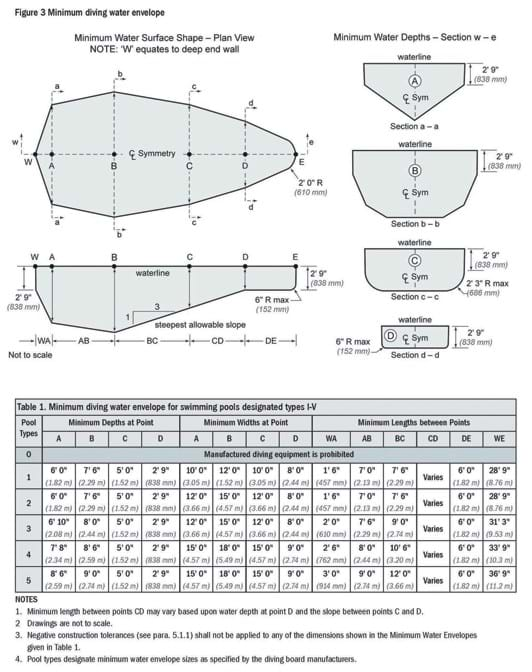General
-
Q:
How do I make a warranty claim?
Please go to our online warranty claim form.
-
Q:
What if I need something custom made?
We do custom rails only. Submit your design to your local distributor and they can contact us to get a quote on the project and then order it for you.
-
Q:
How can I find out prices on your products?
We can provide you with correct part numbers and your local dealer can quote a price.
Pool Slides
-
Q:
What is the maximum weight on a slide?
124.7 kg. (TurboTwister, Typhoon)
113.4 kg. (Rogue2, BigRide, heliX)
79.4 kg. (Cyclone)
-
Q:
Can I replace just one handrail on my Rogue2 slide?
Yes - the handrails are sold separately.
-
Q:
My pool deck is already poured. Can I still install a slide?
Yes. In fact all of our pool slides can be installed after the deck is poured, using the included deck anchors.
-
Q:
How much deck space is needed to install a slide?
The approximate minimum deck spaces for each slide are (see installation guides for exact measurements):
TurboTwister, 4.1m by 2m.
heliX, 2.7m by 1.5m.
Typhoon, 3.5m by 1.2m.
Cyclone, 2m by 1.7m.
Rogue2, 1.7m by 3.2m.
BigRide, 3.3m by 3.2m.
Each installation guide has an aerial view (footprint) that shows the precise deck space needed.
Diving Boards
-
Q:
How do I select the correct diving board for my pool?
To safely install an S.R.Smith diving board, the pool must have a "minimum diving water envelope" as defined by the United States pool industry safety standards (ANSI/APSP/ICC-5 2011 Standard for Residential Inground Swimming Pools or ANSI/NSPI-1 2003 Standard for Public Swimming Pools). Diving envelopes range from a Type 0 (non-diving pool) up to a Type IX (large, commercial swimming pool). These Pool Types are determined by a series of depth measurements, including several width and depth measurements at various points in your pool. The following diagram is one example of a minimum diving water envelope.

Since pools come in many shapes and sizes, it is best to contact a pool professional in your area to measure and type your pool, and provide you with diving board options that are appropriate for your pool. In addition, not all diving boards and stands are designed to work together. Your pool professional can make sure that the diving board and stand you have selected are compatible.
Visit our dealer locator to find a qualified pool professional.
-
Q:
Can I replace my diving board myself?
You should have your diving board properly replaced by a reputable pool professional in your area. Professional installation of your diving board ensures that the board is properly fit to your pool's size and shape. Diving boards should never be removed and used in another pool without proper consultation with a professional. Please visit our dealer locator to search for a qualified pool professional in your area.
-
Q:
My diving board stand is broken, how do I replace it on the same spot?
You can use one of our epoxy kits to reconfigure the bolt pattern for a new stand. The old bolts can be sawed off flush with the deck, and new bolts installed. You may have to move the bolt pattern slightly to avoid the existing bolts.
-
Q:
How do I determine if I should replace my diving board?
Visually inspect the board for any cracks, rusting hardware, or other damage. Any sign of damage is immediate cause for board replacement.
-
Q:
How much deck is needed to install a diving board?
The minimum concrete pad for a residential diving board is 243.8 cm by 122 cm by 15.2 cm. Diving stands have to meet local government codes. Please check with your pool professional and reference your diving board's installation manual for exact requirements.
-
Q:
My pool deck is already poured, can I still install a diving board?
Yes. Epoxy kits are available for surface mounting various bolt patterns to support diving board stands. We also have kits available for pavered decks.
-
Q:
What is the difference between a jump board and a diving board?
A jump board is a board on a stand that has a spring of some sort; a diving board is a board on a stationary, non-spring stand.
Pool Rails
-
Q:
What causes pitting on stainless steel rails?
When the protective chrome-oxide film on the rail breaks down in small spots, severe contaminants such as halide salts can come in contact with the alloy surface, which begins to create pits. This is very common in coastal and other similarly harsh areas. Prevention by regular cleaning is recommended to regenerate and restore the protective film.
-
Q:
What can I do about rust spots on my stainless steel rails?
In order to protect them, stainless steel rails require routine cleaning with gentle soaps or detergents or mild mixtures of ammonia. A number of products are readily available to clean stubborn spots, stains, or discolorations, including Bon Ami, Bar Keepers Friend, 3M Stainless Steel cleaner, Cameo, and Revere Ware Cleaner.
